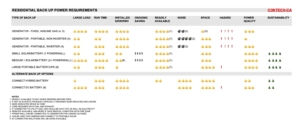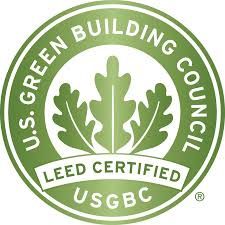Why Consider a Back-up Power Solution?
A home generator, battery, or solar battery back-up is becoming more of an essential household resource than an option. Planning for the immediate challenges and future developments will pay off.
People are spending more time at home than ever. Between working from home, home schooling, and sheltering in place, we come to depend on a reliable and consistent power source at home. Factor in the numerous possible disruptions to power – Public Safety Power Shutoffs (PSPS), rolling black outs, and weather-related events – and a day that you are reliant on a consistent power source can quickly turn into a disaster.
A correctly selected back-up power solution and connection can provide a cost-effective solution to back-up equipment including refrigerators, fans, phone chargers, Internet equipment, vital medical equipment, and lighting.
Which one should I buy?
There are many home back-up power solutions, the following are CONTECH-CA’s recommendations based on published reports and first-hand experience.
First consider what you want to accomplish. The following are four general categories of back-up power solutions:
- Fixed Generator
- Portable Generator
- Battery/Uninterruptible Power Supply (UPS)
- Solar and Battery
To power an entire (medium sized – 1,500 square foot) house you will about a 4 kilowatt (kW) + generator with a 240 volt (V) output. You will need a way of connecting the power source to your home’s power system and a way of safely disconnecting from your electrical utility service (e.g. PG&E) to prevent any “back feeding,” which could be dangerous.
To power specific appliances, you can install a generator outside and run power cords to the house. These types of generators start at 600 watt (W) to 2,000W, and run at 120V. First determine your power needs to narrow your search.

![]() Cost Consideration (Estimates)
Cost Consideration (Estimates)
- Portable generator – $500 to $3,000
- Fixed generator – $7000 to $20,000
- Portable UPS/Battery Unit – $200 to $2,000
- Solar/Storage Battery – $15,000 to $40,000
Generator – Fixed
If your goal is to power your entire house or want auxiliary power to be able to start automatically when there is a power outage, you may want to consider a fixed generator. They are typically more expensive (7-20k vs. 500-3k) then portable options and will require an electrical contractor to install. With regard to recommended manufacturers, Generac is the most popular and they have a full range of residential generators. The advantage of using a popular generator is that most local contractors are familiar with them and spare parts will be easy to find.
Generators are a source of noise and exhaust, therefor many towns have special bulletins with regards to where you can locate a generator on your property. Our town, Fairfax, CA., is considering regulating generators and other Towns already have policies in place, including the City of San Rafael and the City of Larkspur.
Generator – Portable
Portable generators can either be connected to your home electrical system via a special switch or temporary inlet. Alternately, you can run a power cord inside the house to connect essential equipment such as lights, refrigerators, wireless routers, and Internet modems.
Portable Generators can range in size from 500 W to 8000 W.
Inverter type generators are generally more expensive than non-inverter types, but have much better power quality and can be connected to sensitive equipment, which is pretty much most things in a modern home, as most equipment has some form of electronic control which could be damaged buy a regular voltage or frequency from a non-inverter generator. Most electrical engineers and contractors, if they have one, have a Honda. They start at $1000 up to $3500. As this will be powering your most valuable equipment, best to go with a known manufacture.
Non Inverter Generator (sometimes referred to as “regular” generators) are generally cheaper and make more noise. Some lower quality models come be louder than a motorcycle running. As the power they generate is not regulated, they are not suitable to connect directly to sensitive equipment (“sensitive” means high end electronics and expensive appliances, including computers.) These types of generators are typically intended for supporting construction equipment, which are less sensitive to fluctuations in voltage and frequency.
They are available in dual fuel – Gas or propane.
Sizing
| Size | Voltage | Suitable | Fuel |
| 500 to 1000W | 120V | Lights, computer equipment | Gas or propane |
| 1000 to 2000W | 120V | Lights, computer equipment, refrigerators | Gas or propane |
| 2000 to 8000W | 120V / 240V | Lights, computer equipment, refrigerators, air conditioning, and whole house | Gas or propane |
Power quality – Exercise care when connecting sensitive electronic equipment, recommend only use inverter generators similar to the Honda units.
Voltage – regular wiring in a house in the United States is 120V. Larger appliances, such as hot tubs, air conditioning (AC) units, and some dryers are 240V.
Safety concerns
The biggest concern when using a generator, be it portable or fixed, is the exhaust. This is hot, so can burn and start fires if placed near grass. Also, as with any combustion engine, the exhaust (carbon monoxide) is toxic and deadly. Extreme care should be taken when locating a generator. In the recent 2020 hurricane Laura, most deaths were from improper use of portable generators
Care should be taken when storing and managing fuel. Only store fuel in approved containers and remember that fuel degrades over time. You can extend the life of stored fuel (in the generator or in a container) by using an additive (sold in most hardware stores.)
Other Considerations
Portable generators often have a pull starter, which can present a problem for people with shoulder weakness or injury. This may pose a particular challenge for the elderly. Some varieties have the option of an electric starter, but they must be charged to work.
Battery/Uninterruptible power supply (UPS) back up type
With improved battery technology such as lithium ion, battery units have become more popular. Portable Battery Inverter Units are essentially a large rechargeable battery that can generate 120V for home appliances. These are a newer solution, and new models are coming on the market all the time. These can also be used for activities like camping.
The advantages of battery systems are that they:
- need little maintenance apart from making sure they are charged,
- are silent,
- do not generate exhaust, so they can be safely placed inside.
They have limited storage capacity, although some can connect to portable solar panels.
Solar and Battery
Solar panels are designed to shut off when the power goes off, but if the system is coupled with a battery storage system, such as a Tesla Powerwall, the system will automatically switch to battery/solar power. This will be able to run as long as the power generated by the sun is greater than the load used.
Advantages of these systems are that they reduce your energy bill and do not use non-renewable volatile fuels to run, there is no exhaust, and they do not make noise.
Disadvantages are that you need a roof that with good sun exposure and the system can be expensive. However, you can lease the systems. Also, if you rent, your landlord may not want to pay for a system. There are incentive programs aimed at rental properties, such as one through Marin Clean Power. The state of California also provides funding incentives which may help to overcome financial barriers to going solar.
Size – There are many different systems available. It may be helpful to use the Tesla website for sizing and pricing. They have four different sized systems:
| SOLAR SIZE | NUMBER OF PANELS | POWER RATING | ROOF AREA COVERED | What can this power in an outage? |
| Small | 12 | 4kW | 240 sq ft | Typically 4 circuits for essential appliances such as lighting, fridge and computer equipment. |
| Medium | 24 | 8kW | 480 sq ft | Whole house including AC and Electric Vehicle (EV) |
| Large | 36 | 12kW | 720 sq ft | Large whole house including AC and EV |
| X-Large | 48 | 16kW | 960 sq ft | Very Large whole house including AC and EV |
I have one of these systems installed at my house and it works great. For me, one of the biggest advantages is peace of mind. The system will switch from the utility company power (in my case, PG&E) to the Powerwall without flickering the lights, and will return to utility provided power when it’s restored again, without any interruptions in power. This means I don’t have to worry about getting connected and disconnected from generators during a business call or in the middle of the night.
OTHER QUESTIONS
What should I consider when selecting a back-up power supply for my home?
First consider why you want back-up power and think about what you need to have versus what might simply be nice to have. Consider what’s feasible within your budget and importantly, consider the safety and noise nuisance concerns with each option and how you will minimize them.
What do you hope to power with a back-up power supply? Are there alternates to a back-up generator available to you? Do you have any appliances that must be on all the time (these can include medical equipment, AC, or even aquariums.) Can some of your power needs be alternated, or ran periodically rather than simultaneously and all at once? This might change the size (and thus cost) of what you need. Once you have determined the scope of your need, think about cost, safety, and your neighbors (if you live in dense residential areas, especially, consider the noise impact on neighbors and what could be done, safely, to decrease noise nuisance.)
I’ve heard I can Gerry-rig my electric car battery to be a back-up source of power in an emergency. How do I do that? Is it safe?
I personally don’t have any experience of doing this, however I have heard of success stories connecting Toyota Prius to a house, and there are many videos on YouTube on how to do this. As with any electrical system, you need to take care when connecting the equipment. Also, you may void the warranty on your car if it’s being used as a back-up power source.
If I put in solar power, do I need a generator? Don’t I have my own power?
It is a common misconception that you will be able to use solar power if there is a power outage. Unless your solar panels are connected to battery systems, such as a Tesla power wall system, the panels are required by code to shut down. They will not start back up until your utilities (e.g PG&E) power is restored
Does fuel source make a difference?
Gas
Firstly, gas is a flammable liquid and needs to be stored carefully and stored in suitable fuel cans. Gas can also degrade over time. You can use an additive for longer-term storage. This can be problematic as it may be several months between using your generator, and you may not realize your fuel is gone until your generator stops running. If you have a cheaper two-stroke engine you will also need two-stroke oil in addition to gas.
Propane
This is easier to store and you may already have it on hand for barbecues, etc. Some generators are available with dual fuel capabilities (they can use gas or propane) which can be an advantage in a long outage. If the power is off at your house, it may also be off at the gas pumps.
Does the back-up power source turn on automatically when the power goes off, even when I’m out of town?
No. Only fixed generators with automatic start and transfer switches will automatically start. There will be a short break in power between the utility going off and the generator starting. Solar with battery storage will also automatically transfer, if it is the Tesla Powerwall type system. If this is an important feature for you, check with the person installing the system.
How much back-up energy do I need?
To answer this question you need to determine what equipment you want to keep on, and also, what can you live without during an outage. Ultimately, figuring out how much power you need is determined by the appliances you will want to run. This is measured in watts (W) or kilowatts (kW).
Your power needs and your back-up solution will usually be set by the largest piece of equipment in your house that you want to keep running, which is typically your refrigerator. However, if you have an AC system this will be your largest power draw.
One you have determined which appliances you want to run, then decide if you need them to have power consistently or intermittently. Some things that you may want to run intermittently (like a refrigerator), while other thing you may want consistent power for (e.g. your wireless router, modem, or even an aquarium.) Once you have figured out how much power you need and how long you want it for, you will be able calculate the ‘Kilowatt /hours’ (kWh), used to determine what size back-up system you’ll need.
Determining the kind of output you want/need out of a back-up power system depends on your goals. If you just want to power your refrigerator and electronics you’ll come to one decision, or if you want to cover your whole house including AC, you’ll choose a larger power output option.
There are a number of ways to find out the power requirements of various household equipment/appliances. You can look at the label on the back of the equipment which will give you the amount of power it draws in watts, or you can look it up online.
You could also look on your electric utility bill. This will show your maximum power used, and if you have a Utility smart meter it will tell you when that occurred.
Another useful way of finding out your typical power usage is to install a smart meter, such as the Sense monitoring unit. This will tell you detailed information about your power usage. You can also use this information to inform energy saving ideas, by identifying appliances that are left on etc. I have one in my house and it works great.
Will it keep my internet working? What about my phones?
To have working internet, you need to power your router and WIFI unit, but you are also relying on the internet service providers to power their equipment. Last year during California’s PSPS, internet service providers had equipment that relied on power from utilities. Although people may have had home generators, internet service was interrupted. There has been a good deal of work done over the past year to improve internet service provider’s back up power.
Principal, CONTECH-CA
I hope you have found this article useful. Please feel free to send comments or suggestions Brenda.lein@contech-ca.com
***






